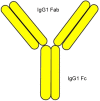Profile of adalimumab and its potential in the treatment of uveitis
- PMID: 27698552
- PMCID: PMC5034916
- DOI: 10.2147/DDDT.S94188
Profile of adalimumab and its potential in the treatment of uveitis
Abstract
Uveitis refers to the presence of intraocular inflammation, and as a strict definition compromises the iris and ciliary body anteriorly and the choroid posteriorly (the uvea). Untreated, uveitis can lead to visual loss or blindness. The etiology of uveitis can include both infectious and noninfectious (usually immune-mediated) causes, the latter of which are often mediated predominantly by Th1 CD4+ T-cells that secrete proinflammatory cytokines. Tumor necrosis factor-alpha (TNF-α) is a proinflammatory cytokine involved in the pathogenesis of uveitis, which at high concentrations can cause excess inflammation and tissue damage. Adalimumab is a recombinant human IgG1 monoclonal antibody specific for human TNF-α. Historically, corticosteroids and methotrexate were used to treat uveitis; however, newer biologic agents such as adalimumab have revolutionized therapy for noninfectious uveitis. Adalimumab has shown efficacy in treating refractory uveitis in multiple settings, including idiopathic disease, juvenile idiopathic arthritis, sarcoidosis, Behçets disease, and uveitis secondary to spondyloarthropathies, among several other noninfectious uveitis conditions. In this paper, we will review the profile of adalimumab, the role of TNF-α in uveitis, discuss safety data, and summarize key articles evaluating the efficacy of adalimumab in treating uveitis secondary to the most commonly associated autoimmune diseases.
Keywords: TNF-α; adalimumab; autoimmune disease; uveitis.
Similar articles
-
The effectiveness of adalimumab treatment for non-infectious uveitis.Immunol Med. 2019 Jun;42(2):79-83. doi: 10.1080/25785826.2019.1642080. Epub 2019 Jul 17. Immunol Med. 2019. PMID: 31315546 Review.
-
Efficacy of adalimumab in young children with juvenile idiopathic arthritis and chronic uveitis: a case series.BMC Res Notes. 2014 May 24;7:316. doi: 10.1186/1756-0500-7-316. BMC Res Notes. 2014. PMID: 24886032 Free PMC article.
-
Anti-TNF therapy for juvenile idiopathic arthritis-related uveitis.Drug Des Devel Ther. 2014 Mar 24;8:341-8. doi: 10.2147/DDDT.S54207. eCollection 2014. Drug Des Devel Ther. 2014. PMID: 24711694 Free PMC article. Review.
-
[Anti-TNF-α in the treatment of uveitis in the Besançon Hospital].J Fr Ophtalmol. 2011 Dec;34(10):697-702. doi: 10.1016/j.jfo.2011.03.011. Epub 2011 Sep 1. J Fr Ophtalmol. 2011. PMID: 21889230 French.
-
Adalimumab for the treatment of uveitis.Expert Rev Clin Immunol. 2017 Mar;13(3):181-188. doi: 10.1080/1744666X.2017.1288097. Expert Rev Clin Immunol. 2017. PMID: 28140700 Review.
Cited by
-
Efficacy and safety of adalimumab in the treatment of non-infectious uveitis: a meta-analysis and systematic review.Drug Des Devel Ther. 2018 Jul 4;12:2005-2016. doi: 10.2147/DDDT.S160431. eCollection 2018. Drug Des Devel Ther. 2018. PMID: 30013320 Free PMC article.
-
Ocular Delivery of Therapeutic Agents by Cell-Penetrating Peptides.Cells. 2023 Apr 1;12(7):1071. doi: 10.3390/cells12071071. Cells. 2023. PMID: 37048144 Free PMC article. Review.
-
Systematic review of studies comparing infliximab and adalimumab in autoimmune uveitis.BMJ Open Ophthalmol. 2023 Jun;8(1):e001303. doi: 10.1136/bmjophth-2023-001303. Epub 2023 Jun 14. BMJ Open Ophthalmol. 2023. PMID: 37493653 Free PMC article.
-
Ocular delivery of proteins and peptides: Challenges and novel formulation approaches.Adv Drug Deliv Rev. 2018 Feb 15;126:67-95. doi: 10.1016/j.addr.2018.01.008. Epub 2018 Jan 13. Adv Drug Deliv Rev. 2018. PMID: 29339145 Free PMC article. Review.
-
Infliximab relieves blood retinal barrier breakdown through the p38 MAPK pathway in a diabetic rat model.Int J Ophthalmol. 2017 Dec 18;10(12):1824-1829. doi: 10.18240/ijo.2017.12.06. eCollection 2017. Int J Ophthalmol. 2017. PMID: 29259899 Free PMC article.
References
-
- Dunn JP. Uveitis. Prim Care. 2015;42(3):305–323. - PubMed
-
- Tracey D, Klareskog L, Sasso EH, Salfeld JG, Tak PP. Tumor necrosis factor antagonist mechanisms of action: a comprehensive review. Pharmacol Ther. 2008;117(2):244–279. - PubMed
-
- Neri P, Zucchi M, Allegri P, Lettieri M, Mariotti C, Giovannini A. Adalimumab (Humira): a promising monoclonal anti-tumor necrosis factor alpha in ophthalmology. Int Ophthalmol. 2011;31(2):165–173. - PubMed
Publication types
MeSH terms
Substances
Grants and funding
LinkOut - more resources
Full Text Sources
Other Literature Sources
Medical
Research Materials


